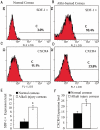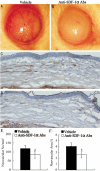Inhibited experimental corneal neovascularization by neutralizing anti-SDF-1α antibody
- PMID: 22553746
- PMCID: PMC3340834
- DOI: 10.3980/j.issn.2222-3959.2012.01.02
Inhibited experimental corneal neovascularization by neutralizing anti-SDF-1α antibody
Abstract
Aim: To explore the effect of SDF-1α on the development of experimental corneal neovascularization (CRNV).
Methods: CRNV was induced by alkali injury in mice. The expression of SDF-1α and CXCR4 in burned corneas was examined by Flow Cytometry. Neutralizing anti-mouse SDF-1α antibody was locally administrated after alkali injury and the formation of CRNV 2 weeks after injury was assessed by Immunohistochemistry. The expression of VEGF and C-Kit in burned corneas was detected by RT-PCR.
Results: The number of CRNV peaks at 2 weeks after alkali injury. Compared to control group, SDF-1α neutralizing antibody treatment significantly decreased the number of CRNV. RT-PCR confirmed that SDF-1α neutralizing antibody treatment resulted in decreased intracorneal VEGF and C-Kit expression.
Conclusion: SDF-1α neutralizing antibody treated mice exhibited impaired experimental CRNV through down regulated VEGF and C-Kit expression.
Keywords: alkali injury; chemokine; corneal neovascularization.
Figures



Similar articles
-
Anti-apoptosis effects of vascular endothelial cadherin in experimental corneal neovascularization.Int J Ophthalmol. 2015 Dec 18;8(6):1083-8. doi: 10.3980/j.issn.2222-3959.2015.06.01. eCollection 2015. Int J Ophthalmol. 2015. PMID: 26682152 Free PMC article.
-
Interleukin (IL)-17A Promotes Angiogenesis in an Experimental Corneal Neovascularization Model.Curr Eye Res. 2017 Mar;42(3):368-379. doi: 10.1080/02713683.2016.1196705. Epub 2016 Jul 15. Curr Eye Res. 2017. PMID: 27419340
-
Critical role of SDF-1α-induced progenitor cell recruitment and macrophage VEGF production in the experimental corneal neovascularization.Mol Vis. 2011;17:2129-38. Epub 2011 Aug 10. Mol Vis. 2011. PMID: 21850188 Free PMC article.
-
Inhibitory effect of CCR3 signal on alkali-induced corneal neovascularization.Int J Ophthalmol. 2012;5(3):251-7. doi: 10.3980/j.issn.2222-3959.2012.03.01. Epub 2012 Jun 18. Int J Ophthalmol. 2012. PMID: 22773968 Free PMC article.
-
Critical Role of IP-10 on Reducing Experimental Corneal Neovascularization.Curr Eye Res. 2015 Sep;40(9):891-901. doi: 10.3109/02713683.2014.968934. Epub 2014 Oct 13. Curr Eye Res. 2015. PMID: 25309995
Cited by
-
Current and emerging therapies for corneal neovascularization.Ocul Surf. 2018 Oct;16(4):398-414. doi: 10.1016/j.jtos.2018.06.004. Epub 2018 Jun 20. Ocul Surf. 2018. PMID: 29908870 Free PMC article. Review.
-
Anti-apoptosis effects of vascular endothelial cadherin in experimental corneal neovascularization.Int J Ophthalmol. 2015 Dec 18;8(6):1083-8. doi: 10.3980/j.issn.2222-3959.2015.06.01. eCollection 2015. Int J Ophthalmol. 2015. PMID: 26682152 Free PMC article.
-
Strategies for local gene therapy of corneal allograft rejection.Middle East Afr J Ophthalmol. 2013 Jan-Mar;20(1):11-25. doi: 10.4103/0974-9233.106382. Middle East Afr J Ophthalmol. 2013. PMID: 23580848 Free PMC article. Review.
-
SDF‑1α/CXCR4 signaling promotes capillary tube formation of human retinal vascular endothelial cells by activating ERK1/2 and PI3K pathways in vitro.Mol Med Rep. 2022 Oct;26(4):305. doi: 10.3892/mmr.2022.12821. Epub 2022 Aug 10. Mol Med Rep. 2022. PMID: 35946444 Free PMC article.
References
-
- Ambati BK, Nozaki M, Singh N, Takeda A, Jani PD, Suthar T, Albuquerque RJ, Richter E, Sakurai E, Newcomb MT, Kleinman ME, Caldwell RB, Lin Q, Ogura Y, Orecchia A, Samuelson DA, Agnew DW, St Leger J, Green WR, Mahasreshti PJ, Curiel DT, Kwan D, Marsh H, Ikeda S, Leiper LJ, Collinson JM, Bogdanovich S, Khurana TS, Shibuya M, Baldwin ME, Ferrara N, Gerber HP, De Falco S, Witta J, Baffi JZ, Raisler BJ, Ambati J. Corneal avascularity is due to soluble VEGF receptor-1. Nature. 2006;443:993–997. - PMC - PubMed
-
- Zhang S, Ma J. Ocular neovascularization: Implication of endogenous angiogenic inhibitors and potential therapy. Prog Retin Eye Res. 2007;26:1–37. - PubMed
LinkOut - more resources
Full Text Sources
